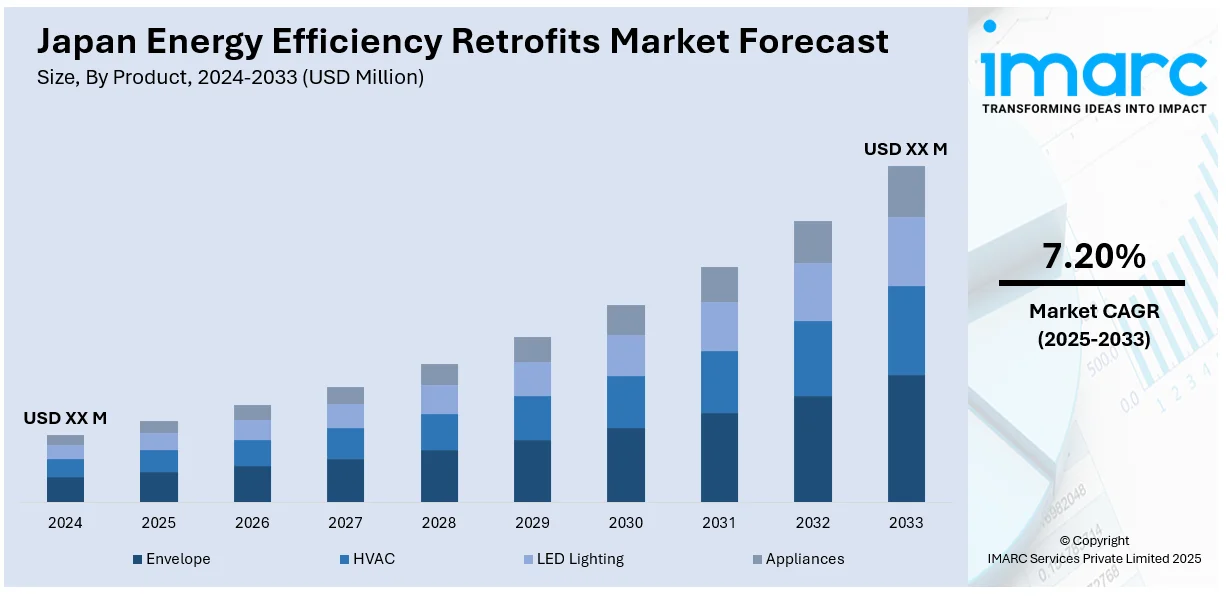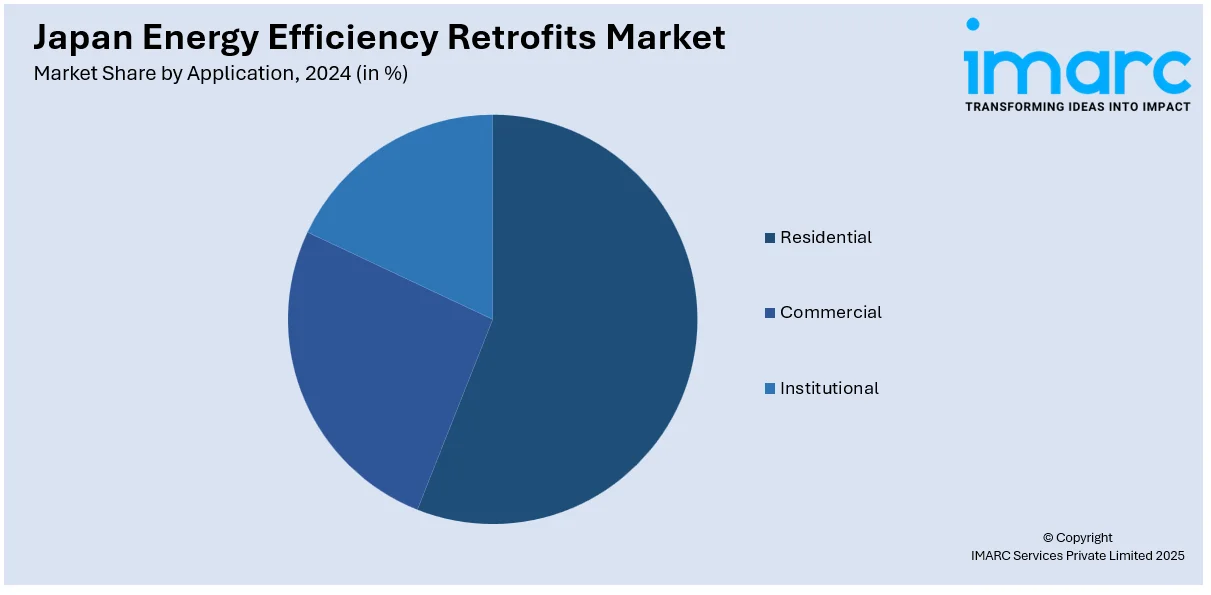
Japan Energy Efficiency Retrofits Market Size, Share, Trends and Forecast by Product, Application, and Region, 2025-2033
Japan Energy Efficiency Retrofits Market Overview:
The Japan energy efficiency retrofits market size is projected to exhibit a growth rate (CAGR) of 7.20% during 2025-2033. At present, rising energy costs are generating awareness about power saving, encouraging more individuals to take action and employ advanced retrofitting systems. Local government agencies are including energy efficiency as a key requirement in urban planning, further supporting retrofitting efforts. Besides this, the growing investments in urban redevelopment projects that require reliable upgrade solutions are contributing to the expansion of the Japan energy efficiency retrofits market share.
|
Report Attribute
|
Key Statistics
|
|---|---|
|
Base Year
|
2024 |
|
Forecast Years
|
2025-2033
|
|
Historical Years
|
2019-2024
|
| Market Growth Rate 2025-2033 | 7.20% |
Japan Energy Efficiency Retrofits Market Trends:
Increasing energy costs
High energy costs are positively influencing the market in Japan. As energy prices remain high, retrofitting older buildings with efficient systems has become a cost-saving strategy. Japan’s rising population is also catalyzing power demand, making energy efficiency important. As per the worldometers, the estimated population of Japan in 2025 will be 123,103,479 individuals at mid-year. Retrofitting helps lower operational costs by improving insulation, upgrading to light emitting diode (LED) lighting, installing reliable heating, ventilation, and air conditioning (HVAC) systems, and using energy management technologies. These upgrades reduce waste and refine energy performance without requiring complete reconstruction. For businesses, lower energy bills improve profit margins, while residential users benefit from more affordable utility costs. In high-cost energy environments, payback periods for retrofits are shorter, making the investment more attractive. Government support, in the form of rebates and incentives, is adding further motivation. Additionally, high energy costs are generating awareness about energy conservation, leading more people to take action. Retrofitting is especially relevant in Japan, where many buildings are several decades old and were built before modern efficiency standards.

Rising investments in urban redevelopment projects
Increasing investments in urban redevelopment projects are impelling the Japan energy efficiency retrofits market growth. As cities are modernizing infrastructure and renewing old neighborhoods, retrofitting is gaining popularity as a natural part of the redevelopment process. These projects often target aging buildings that were built before energy efficiency became a priority, making them the ideal choice for upgrades. During redevelopment, it is easier and more cost-effective to implement energy-efficient solutions, such as better insulation, advanced lighting systems, smart HVAC units, and energy management systems. Local government agencies are including energy efficiency as a key requirement in urban planning, further supporting retrofitting efforts. Redevelopment also aligns with Japan’s sustainability goals, supporting a transition to greener and smarter cities. In densely populated urban areas, improving the energy performance of buildings reduces the overall environmental footprint and helps manage rising power demands. Property developers and owners are also benefiting, as energy-efficient buildings are gaining traction among tenants and have higher market value. As redevelopment is accelerating in cities like Tokyo and Osaka, the demand for energy efficiency retrofits is growing, making it an essential part of Japan’s urban transformation strategy. In October 2024, construction activities at the ‘Sengakuji Station District Type 2 Urban Redevelopment’ in Tokyo began, following the project's announcement in the first quarter of 2018. The initiative encompassed the building of a 30-story above-ground and three-story below-ground, 145m mixed-use tower, featuring a floor area of 110,644m2 on 1.3ha of land located in Minato-Ku, Tokyo, Japan.
Japan Energy Efficiency Retrofits Market Segmentation:
IMARC Group provides an analysis of the key trends in each segment of the market, along with forecasts at the country and regional levels for 2025-2033. Our report has categorized the market based on product and application.
Product Insights:
- Envelope
- HVAC
- LED Lighting
- Appliances
The report has provided a detailed breakup and analysis of the market based on the product. This includes envelope, HVAC, LED lighting, and appliances.
Application Insights:

- Residential
- Single-Family
- 2+ Unit Building
- Mobile Home
- Commercial
- Food Sales and Service
- Lodging
- Mercantile
- Office Buildings
- Public Assembly
- Warehouse/Storage
- Others
- Institutional
- Education
- Healthcare
- Public Order and Safety
- Worship Buildings
A detailed breakup and analysis of the market based on the application have also been provided in the report. This includes residential (single-family, 2+ unit building, and mobile home), commercial (food sales and service, lodging, mercantile, office buildings, public assembly, warehouse/storage, and others), and institutional (education, healthcare, public order and safety, and worship buildings).
Regional Insights:
- Kanto Region
- Kansai/ Kinki Region
- Central/Chubu Region
- Kyushu-Okinawa Region
- Tohoku Region
- Chugoku Region
- Hokkaido Region
- Shikoku Region
The report has also provided a comprehensive analysis of all the major regional markets, which include Kanto Region, Kansai/Kinki Region, Central/Chubu Region, Kyushu-Okinawa Region, Tohoku Region, Chugoku Region, Hokkaido Region, and Shikoku Region.
Competitive Landscape:
The market research report has also provided a comprehensive analysis of the competitive landscape. Competitive analysis such as market structure, key player positioning, top winning strategies, competitive dashboard, and company evaluation quadrant has been covered in the report. Also, detailed profiles of all major companies have been provided.
Japan Energy Efficiency Retrofits Market News:
- In January 2025, research was carried out in Japan to assess the effects of insulation materials on energy efficiency through BIM-based simulations for retrofitting existing buildings. The case examined was an apartment complex in Kanazawa, Japan. It was found that the optimal retrofitting scenario was one that resulted in the least energy usage, indicating that the insulation material would exhibit reduced energy usage in comparison to the regional average. This method guaranteed that retrofitting strategies were economically feasible and environmentally sustainable.
- In July 2024, Eneos Renewable Energy planned to incorporate energy storage into an existing solar PV facility in southern Japan, having successfully obtained subsidies to help fund the project. It also aimed to retrofit BESS at the plant. The system was created acknowledging that planning optimal market optimization of BESS assets posed difficulties in the country due to the insufficient connection between platforms for predicting renewable energy generation and electricity demand and those for bidding and transactions.
Japan Energy Efficiency Retrofits Market Report Coverage:
| Report Features | Details |
|---|---|
| Base Year of the Analysis | 2024 |
| Historical Period | 2019-2024 |
| Forecast Period | 2025-2033 |
| Units | Million USD |
| Scope of the Report | Exploration of Historical Trends and Market Outlook, Industry Catalysts and Challenges, Segment-Wise Historical and Future Market Assessment:
|
| Products Covered | Envelope, HVAC, LED Lighting, Appliances |
| Applications Covered |
|
| Regions Covered | Kanto Region, Kansai/Kinki Region, Central/ Chubu Region, Kyushu-Okinawa Region, Tohoku Region, Chugoku Region, Hokkaido Region, Shikoku Region |
| Customization Scope | 10% Free Customization |
| Post-Sale Analyst Support | 10-12 Weeks |
| Delivery Format | PDF and Excel through Email (We can also provide the editable version of the report in PPT/Word format on special request) |
Key Questions Answered in This Report:
- How has the Japan energy efficiency retrofits market performed so far and how will it perform in the coming years?
- What is the breakup of the Japan energy efficiency retrofits market on the basis of product?
- What is the breakup of the Japan energy efficiency retrofits market on the basis of application?
- What is the breakup of the Japan energy efficiency retrofits market on the basis of region?
- What are the various stages in the value chain of the Japan energy efficiency retrofits market?
- What are the key driving factors and challenges in the Japan energy efficiency retrofits market?
- What is the structure of the Japan energy efficiency retrofits market and who are the key players?
- What is the degree of competition in the Japan energy efficiency retrofits market?
Key Benefits for Stakeholders:
- IMARC’s industry report offers a comprehensive quantitative analysis of various market segments, historical and current market trends, market forecasts, and dynamics of the Japan energy efficiency retrofits market from 2019-2033.
- The research report provides the latest information on the market drivers, challenges, and opportunities in the Japan energy efficiency retrofits market.
- Porter's five forces analysis assist stakeholders in assessing the impact of new entrants, competitive rivalry, supplier power, buyer power, and the threat of substitution. It helps stakeholders to analyze the level of competition within the Japan energy efficiency retrofits industry and its attractiveness.
- Competitive landscape allows stakeholders to understand their competitive environment and provides an insight into the current positions of key players in the market.
Need more help?
- Speak to our experienced analysts for insights on the current market scenarios.
- Include additional segments and countries to customize the report as per your requirement.
- Gain an unparalleled competitive advantage in your domain by understanding how to utilize the report and positively impacting your operations and revenue.
- For further assistance, please connect with our analysts.
 Request Customization
Request Customization
 Speak to an Analyst
Speak to an Analyst
 Request Brochure
Request Brochure
 Inquire Before Buying
Inquire Before Buying




.webp)




.webp)












